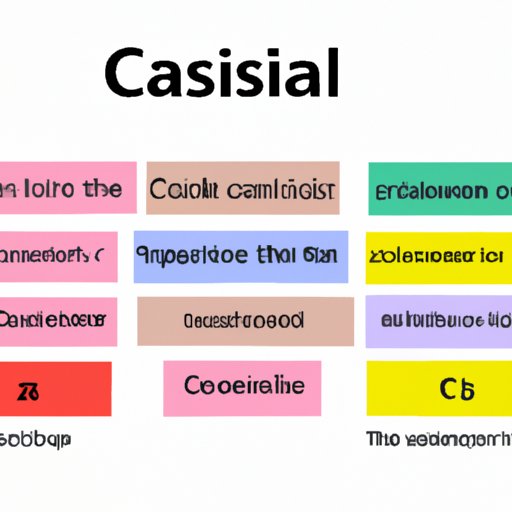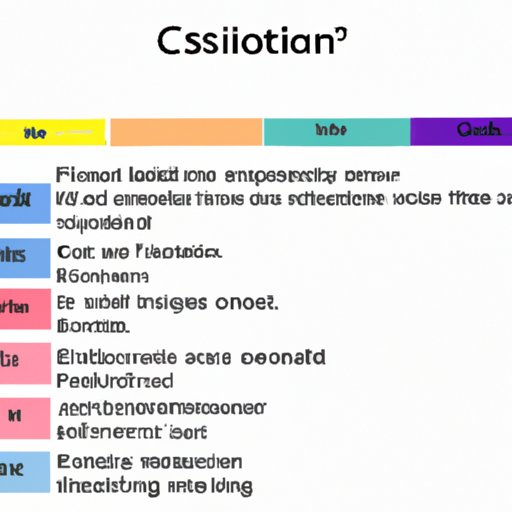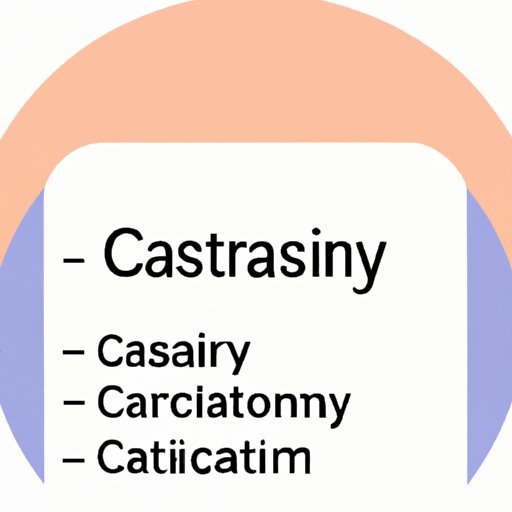Introduction
Classification is a process used to organize information into categories and subcategories. In science, classification is an important tool used to organize data and make sense of complex information. This article will explore what classify means in science, examining the definition of classification, the role of classification in scientific research, and how it is used in different fields to make discoveries.

Exploring the Definition of Classify in Science
Classification is the process of organizing data into categories and subcategories based on shared characteristics. It is an important tool used in science to make sense of large amounts of data. By classifying data, scientists can more easily identify patterns and trends, as well as make predictions about future outcomes.
There are several different types of classification used in science. The most common type is hierarchical classification, which groups objects or concepts into a hierarchical structure based on their similarities and differences. For example, a biological classification system might group animals into the following hierarchy: Kingdom, Phylum, Class, Order, Family, Genus, Species. Other types of classification include functional classification, which groups objects based on their purpose, and categorical classification, which groups objects into categories such as color or size.
Classification is also used to organize data in other ways. For example, scientists may use classification to group data points according to certain criteria, such as age, gender, or geographical location. Classification can also be used to compare different sets of data, or to identify outliers in a dataset.
Understanding the Role of Classification in Scientific Research
Classification is an important part of scientific research. It helps scientists make sense of large amounts of data and enables them to identify patterns and trends. It also allows them to draw conclusions from their data and make predictions about future outcomes. Classification can help researchers focus on specific areas of study, allowing them to make more informed decisions and develop better hypotheses.
In addition, classification can help scientists identify relationships between different variables. For example, if a scientist is studying a particular species of animal, they may use classification to determine which environmental factors influence its behavior. By grouping data points according to these factors, the scientist can gain insights into how the species responds to different stimuli. This can then be used to make predictions about how the species will respond in the future.
Classification also has practical applications in many fields of science. It is used in medicine to diagnose and treat illnesses, in ecology to understand the interactions between species, and in psychology to study behavior. In all these cases, classification can help scientists make sense of complicated data and draw meaningful conclusions.
Examining the Benefits of Organizing Data Through Classification
Organizing data through classification has many benefits. One of the most important is that it helps scientists understand data more clearly. By grouping data into categories and subcategories, researchers can identify patterns and trends that would otherwise be difficult to see. This can help them draw meaningful conclusions and make reliable predictions.
Classification can also help researchers save time and money. By organizing data into categories, researchers can more quickly and efficiently analyze and interpret data. This can help them make decisions faster and reduce the costs associated with research.
Finally, classification can help scientists make connections between different areas of study. By grouping data according to certain criteria, researchers can identify relationships between different variables. This can lead to new insights and discoveries that would otherwise remain hidden.

Investigating How Classification is Used in Different Fields of Science
Classification is used in many different fields of science. In biology, for example, scientists use classification to organize living organisms into categories based on their characteristics. This helps scientists understand the diversity of life and make predictions about how organisms will interact with each other. In astronomy, classification is used to group stars, planets, and galaxies according to their size, composition, and other characteristics.
Classification is also used in geology, chemistry, and physics. In each of these fields, classification is used to group data points according to certain criteria, such as temperature, pressure, or density. This helps scientists understand the physical properties of different materials and make predictions about how they will behave under different conditions.

Analyzing How Taxonomy and Classification are Related
Taxonomy and classification are two related terms that are often used interchangeably. However, they are not the same. Taxonomy is the branch of science that studies the classification of living things. It is concerned with identifying, naming, and categorizing organisms according to their characteristics. Classification, on the other hand, is the process of organizing data into categories and subcategories based on shared characteristics.
Taxonomy and classification are both important tools used in science. Taxonomy helps scientists identify, name, and categorize different organisms. Classification helps scientists organize data and make sense of complex information. Together, they can provide valuable insights into the natural world and help scientists make predictions about future outcomes.
Exploring the Impact of Classification on Scientific Discovery
Classification has had a significant impact on scientific discovery. By organizing data into categories and subcategories, scientists can more easily identify relationships between different variables. This can lead to new insights and discoveries that would otherwise remain hidden. For example, the use of classification helped Charles Darwin develop his theory of evolution by natural selection.
Classification has also been used to discover new species. In the 19th century, for example, botanists used classification to identify hundreds of new plants. Today, classification is still being used to discover new species, as well as to understand how existing species interact with each other and their environment.
Conclusion
Classification is an important tool used in science to make sense of large amounts of data. It is used to organize data into categories and subcategories based on shared characteristics, helping scientists identify patterns and trends. Classification is also used to compare different sets of data, identify relationships between different variables, and make predictions about future outcomes. Finally, classification has had a significant impact on scientific discovery, leading to new insights and discoveries that would otherwise remain hidden.
In conclusion, classification is an essential tool used in science to make sense of complex information and uncover new insights. It is an invaluable tool for understanding the natural world and making predictions about future outcomes.
(Note: Is this article not meeting your expectations? Do you have knowledge or insights to share? Unlock new opportunities and expand your reach by joining our authors team. Click Registration to join us and share your expertise with our readers.)
